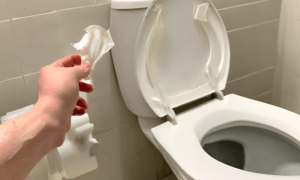Introduction
Understanding the Purpose of Utility Flags
Utility flags in your yard serve a crucial role in safeguarding your property and the community. They mark the locations of underground utilities, such as gas, water, or electrical lines. These flags are a visual indication of potential hazards and help prevent accidental damage to these essential services during excavation or construction.
The Importance of Safety and Compliance
Safety is paramount when it comes to utility flags. Complying with the guidelines for flag placement and removal not only ensures your safety but also prevents costly utility disruptions and potential fines. In this guide, we’ll explore why and when utility flags are placed and how to determine the appropriate time for their removal.

Why Are Utility Flags in My Yard?
Exploring Common Reasons for Utility Flag Placement
Utility flags mysteriously popping up in your yard can leave you wondering why they are there. In this chapter, we will delve into the common reasons for utility flag placement, shedding light on the significance of these colorful markers in your outdoor space.
Understanding the Purpose
Utility companies and contractors have a vital interest in ensuring the safety and functionality of underground utilities. These utilities encompass a wide range of infrastructure, including water lines, gas pipes, electricity cables, and telecommunication wires. When you see utility flags sprouting like colorful flowers across your lawn, it’s a sign that something significant is about to happen beneath the surface.
1. Upcoming Construction or Repairs
One of the primary reasons utility flags make an appearance in your yard is to signal upcoming construction or repair projects. These projects often involve digging or excavating the ground near underground utilities. Here’s why these flags play a crucial role in such scenarios:
Safety First: Utility flags are a critical safety measure. They serve as visual warnings, alerting anyone conducting excavation or construction work that there are valuable and potentially fragile utilities lurking beneath the soil. By marking these utilities in advance, they reduce the risk of accidents and service interruptions.
Preservation of Services: Underground utilities are the lifeblood of our modern infrastructure. Damaging them can result in costly disruptions to essential services like water, gas, electricity, and internet connectivity. Utility flags help pinpoint the precise locations of these utilities, enabling workers to dig with caution and precision.
Compliance with Regulations: Many regions have strict regulations in place to prevent accidents and protect vital infrastructure. Contractors and utility companies are often required by law to mark the locations of underground utilities before commencing any excavation work. Failure to do so can lead to fines and legal consequences.
2. Locating Utilities for Future Projects
Utility flags aren’t always a sign of imminent construction or repairs. Sometimes, they’re placed to mark the locations of underground utilities for future reference. This can be helpful for a variety of reasons:
Landscaping and Gardening: If you’re planning to revamp your yard or garden, knowing the locations of underground utilities is crucial. It prevents accidental damage when planting trees, installing fences, or digging for landscaping projects.
Property Assessment: When buying or selling a property, having a record of utility flag placements can be valuable. It helps potential buyers understand the property’s utility infrastructure and can impact property values.
Routine Maintenance: Utility companies may periodically inspect and maintain their underground infrastructure. Having utility flags in place makes it easier to locate and access these utilities when needed.
Understanding the reasons behind utility flag placement underscores their importance in preventing accidents and ensuring the continued operation of vital services. In the upcoming chapters, we will delve deeper into the specifics of different types of utility flags, their colors, and what each color signifies. So, the next time you spot those colorful flags in your yard, you’ll have a better understanding of why they’re there and what they mean for your property and community.

The Process of Utility Flag Placement
Who Places Utility Flags and Why?
Utility flags are typically placed by authorized personnel, such as utility company employees or contractors. These professionals follow established procedures and guidelines to ensure accurate placement. Understanding the responsible parties and their motivations for flagging your yard can help clarify the purpose of these markers.
The Roles of Utility Companies and Contractors
- Utility Companies: One of the primary entities responsible for placing utility flags is the utility company itself. These companies are tasked with managing and maintaining a network of underground utilities, including water pipes, gas lines, electrical cables, and telecommunications infrastructure. They place flags to mark the location of these utilities in and around your property.
- Contractors: In some cases, utility companies may hire contractors to assist with flag placement. These contractors are often experts in utility locating and have the necessary training and equipment to ensure precise markings. Utility companies may collaborate with contractors to meet high-demand periods or during extensive construction projects.
Why Utility Flags Are Placed
Utility flags serve several critical purposes, all aimed at protecting lives, property, and infrastructure:
- Safety: The primary motivation behind utility flag placement is safety. Underground utilities can pose serious risks if damaged during excavation or construction activities. Gas leaks, electrical shocks, or water pipe bursts can result in accidents, injuries, or even fatalities. Flagging the location of these utilities helps prevent such incidents.
- Damage Prevention: When homeowners or construction crews plan to dig, they often need to excavate areas where underground utilities are present. Utility flags act as a visual guide, alerting individuals to the potential hazards below. This prevents unintentional damage to essential infrastructure, saving time and money on repairs.
- Regulatory Compliance: Many jurisdictions have regulations in place that require utility companies to mark the location of their underground assets before any excavation work begins. This legal requirement ensures that construction and excavation activities are conducted safely and in compliance with local laws.
The Importance of Accurate Marking
Accurate placement of utility flags is essential to avoid potential disasters. Utility companies use specialized equipment and knowledge to precisely mark the location of underground lines. By providing accurate information, they contribute to the safety of excavation and construction activities in your yard.
Here’s why accuracy matters:
- Preventing Accidents: Precise flag placement ensures that excavators and construction crews know the exact location of utilities. This knowledge helps them work around these utilities safely, reducing the risk of accidents.
- Cost Savings: Accurate marking minimizes the chances of damaging underground utilities, which can be expensive to repair. Preventing such damage not only saves money but also prevents service disruptions and potential fines for violating local regulations.
- Efficiency: Accurate flag placement allows construction and excavation projects to proceed smoothly. Workers can confidently navigate the work area without unnecessary delays caused by uncertainty about underground utilities.
In summary, utility flags are placed by authorized personnel, including utility company employees and contractors, to ensure safety, prevent damage to underground utilities, and comply with regulations. The accuracy of these markings is paramount, as it helps protect lives, property, and infrastructure while also streamlining construction and excavation activities. Understanding the roles and motivations behind utility flag placement underscores their significance in maintaining a safe and efficient working environment in your yard.

When Can I Safely Remove Utility Flags?
Determining the Appropriate Timeline for Removal
Utility flags are essential tools for ensuring the safety of excavation and construction projects. They serve as visual indicators of underground utilities, helping workers avoid potentially dangerous situations. However, once the work is completed, removing these flags becomes necessary to restore the area to its normal state. But when is it safe and permissible to do so? In this chapter, we will delve into the various factors that impact the decision to remove utility flags and guide you through the process of determining the appropriate timeline for removal.
Factors That Impact Flag Removal
Several key factors come into play when deciding when to remove utility flags. Understanding these factors is crucial to ensuring the safety and compliance of your project. Let’s explore them in detail:
1. Completion of Excavation or Construction Work:
– The primary reason for placing utility flags is to identify the location of underground utilities during excavation or construction. Therefore, the most straightforward indicator for flag removal is the completion of the work. Once the project is finished, and you no longer require the information provided by the flags, you can consider removing them.
2. Clearance from Utility Companies:
– Utility companies must be involved in the flag removal process. They will typically need to inspect the site to ensure that their underground utilities remain undisturbed and that no damage has occurred during the project. Once they give the green light and provide clearance, you can proceed with removing the flags.
3. Compliance with Local Ordinances:
– Local regulations and ordinances play a significant role in determining when and how utility flags can be removed. Some municipalities may have specific guidelines regarding flag removal, including timelines and procedures. It’s essential to consult with local authorities and ensure that you are in compliance with all applicable regulations.
4. Safety Considerations:
– Safety should always be a top priority when deciding to remove utility flags. Even if the work is completed, if there is any doubt about the safety of the area or the potential for future excavations, it may be advisable to leave the flags in place for a longer period. This extra caution can prevent accidents and ensure the ongoing safety of the site.
5. Documentation and Record-Keeping:
– Proper documentation of the flag removal process is essential. Keep records of when the flags were initially placed, when the work was completed, and when they were removed. This documentation can be valuable for future reference, especially if there are any disputes or issues related to the project.
6. Environmental Considerations:
– In some cases, there may be environmental factors to consider, such as wildlife nesting or protected vegetation. These factors can impact the timing of flag removal and may require coordination with environmental authorities.
7. Future Planning:
– Finally, it’s essential to think about any potential future excavation or construction projects in the area. If there are plans for additional work in the same location, it may be wise to leave the utility flags in place to avoid the cost and effort of re-marking the utilities.
The decision to remove utility flags is a complex one that depends on multiple factors, including the completion of work, clearance from utility companies, local regulations, safety concerns, documentation, environmental considerations, and future plans. By carefully considering these factors and following the appropriate procedures, you can ensure that utility flags are removed safely and in compliance with all relevant guidelines. In the next chapter, we will discuss the step-by-step process for flag removal, providing you with a comprehensive guide to handling this crucial aspect of your project.

How to Properly Remove Utility Flags
Step-by-Step Guide to Safe and Responsible Flag Removal
Removing utility flags is a straightforward process, but it must be done carefully and responsibly. We’ll provide a step-by-step guide that covers the proper techniques for flag removal. Following these steps ensures that you maintain safety and compliance throughout the process.
Step 1: Gather the Necessary Equipment
Before you begin removing utility flags, it’s essential to gather the necessary equipment. You’ll need:
- Safety Gear: Prioritize your safety by wearing appropriate personal protective equipment, including gloves, safety goggles, and a helmet if required.
- Flag Removal Tools: You’ll need tools such as a shovel, spade, or flag removal device designed for the task. Ensure that these tools are in good condition to avoid accidents.
- Communication: Keep a smartphone or two-way radio handy in case you need to contact utility personnel for guidance or in case of emergencies.
Step 2: Identify the Flag’s Purpose
Utility flags come in various colors, each indicating a different type of utility. Before removal, identify the flag’s purpose by referring to any accompanying documentation or by contacting your local utility company. Knowing what the flag represents helps you take appropriate precautions.
Step 3: Verify Local Regulations
Local regulations may dictate specific procedures for utility flag removal. We’ll emphasize the importance of checking with your local authorities or utility companies to ensure compliance. By adhering to these regulations, you prevent potential legal issues and maintain a safe environment.
Some common regulations to be aware of include:
– Digging Permits: In some areas, you may need a permit to excavate around utility flags. Check with your local permitting office to ensure you’re in compliance.
– Depth Guidelines: Regulations might specify how deep you can dig near utility flags to avoid damaging underground utilities. Be sure to follow these guidelines.
– Utility Notification: Many areas require you to notify the utility company before digging near their lines. This notification helps ensure that a utility representative is present during the excavation to provide guidance and oversee safety.
Step 4: Assess the Situation
Before you begin removing a utility flag, assess the situation carefully. Look for any signs of damage, wear, or deterioration on the flag or its markings. If you notice any issues, report them to the utility company immediately.
Step 5: Remove the Flag
Now, you’re ready to remove the utility flag. Follow these steps:
- Digging Safely: Use your shovel or flag removal tool to excavate around the flag gently. Be cautious not to damage any underlying utilities.
- Detach the Flag: Once you’ve exposed the flag’s base, gently detach it from the ground. Avoid using excessive force, which could cause damage.
- Inspect the Area: After flag removal, inspect the area for any signs of damage or exposed utility lines. If you find any, stop work immediately and contact the utility company.
Step 6: Properly Dispose of the Flag
Dispose of the utility flag according to local regulations. Some areas may require you to return the flag to the utility company, while others allow for responsible disposal. Always follow the guidelines provided by local authorities.
Step 7: Record the Removal
Maintain a record of the flag removal process, including the date, location, and any observations made during the procedure. This documentation can be valuable in case of future inquiries or disputes.
Step 8: Backfill and Restore
If you had to dig a hole during flag removal, ensure that you backfill it properly, following any local guidelines for safety and soil compaction. Restore the area to its original condition as closely as possible.
Step 9: Communicate Any Issues
If you encounter any problems or concerns during the flag removal process, promptly communicate them to the utility company and relevant authorities. Timely reporting can prevent accidents and minimize potential damage.
By following these steps and adhering to local regulations, you can safely and responsibly remove utility flags. Remember that safety and compliance are paramount when dealing with underground utilities, and taking the extra precautions outlined in this guide helps ensure a smooth and trouble-free flag removal process.
Conclusion
Balancing Yard Aesthetics with Safety
Utility flags play a crucial role in safeguarding your property, but they can affect the aesthetics of your yard. As a responsible property owner, you should strike a balance between safety and visual appeal. By understanding why, when, and how to remove utility flags, you can enjoy a safe and aesthetically pleasing yard.
Responsible Flag Removal for a Beautiful and Secure Yard
In conclusion, responsible utility flag removal is essential for maintaining a beautiful and secure yard. By following the guidelines and considerations outlined in this guide, you can confidently decide when and how to remove utility flags, ensuring the safety of your property and the surrounding community.
If you want to learn about smoke detector’s green light then delve into our article Decoding the Green Blinking Light on Your Smoke Detector.















